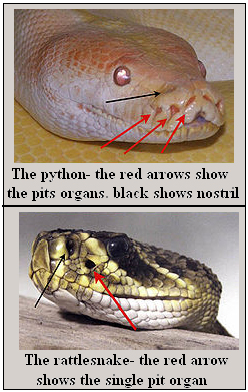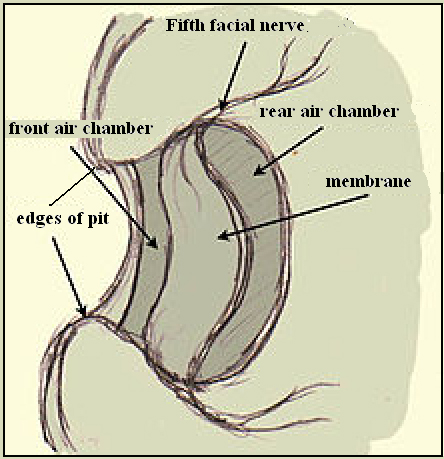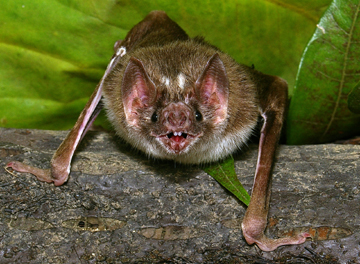Amazing Facts About Wildlife
The vampire bat and some snakes have ‘eyes’ that ‘see’ heat in the place of light, says S.Ananthanarayanan
The advantage of seeing with heat, instead of light, is first, that it can be done in the night. The second thing is that an animal sometimes needs to more than only the shape of its prey, it also needs to identify a vulnerable spot, where blood flows and the
animal is most sensitive. In the case of the vampire bat, the whole objective is 25 cc of blood, so it needs to strike an artery or not at all! A paper just published in Nature, by a group of scientists in California, Maryland and Venezuela on the heat-detecting
machinery in the vampire bat, complements earlier work on the molecular bases of the same ability in snakes.

The Python
The pit vipers, as well as boas and pythons, have ‘pits’ or depressions between the nostril and the eye, which are sensitive to heat. The depression in the pit viper is a deep cavity in the upper jaw, with a narrow opening, so that it works like a pinhole camera.
Heat radiation forms an image, although rather blurred, and in the case of vipers, on a membrane that is suspended inside the cavity. The membrane is rich in nerve tissue that is sensitive to photons of infra red light, which is radiated from warm blooded
prey and the cavities act like a pair of eyes that work in the infra red. In the case of the python and the boa, the heat sensitive surface is not a membrane but the cavity lining.
There are some reasons for the evolution of a special organ like this. The first is that the eyes, which work in visible light, cannot work in the infra red. The reason is that the nerves in the eye detect light through photochemical reactions that the photons
of light set off. Infra red photons do not have the energy to be detected in the same way. The second reason is that most lens materials are opaque to infra red radiation, and hence the need for a pin-hole camera construction, which eliminates the lens. A
third reason is the need for the detection mechanism to very rapidly cool, once heat has been detected, and be ready for another signal. For this requirement, the detection mechanism needs to be different from the photochemical route followed in the eyes.

The pit
The heat detecting mechanism in the pit viper is a heat sensitive ‘ion channel’, which nerve cells use to communicate. The way nerve cells communicate is by creating changes in the concentration of their chemical contents, so that electric charges build up,
till they ‘fire’ and transfer from one cell to another. Changes in contents of cells, for charges to build, need the entry of chemical groups, called ions, through the cell wall and there are specific areas where this is possible. The ion channel called the
Transient Receptor Potential Ion channel, or TRPA1, is a feature in the cell wall, which is sensitive both to heat as well as pungent chemicals, like those present in mustard oil, and this channel is abundant in the nerve bundles found in the heat sensitive
pits.
TRPA1 in vipers has evolved to be most sensitive to IR radiation from objects at about 28° C, the temperature of a warm blooded animal. In the normal state, the nerve fibres are firing at a constant rate, because of the normal IR radiation from the surroundings.
But if there is a warm object, the heat strikes the cells and they begin firing at a faster rate. The sensitivity has been estimated to be better than 0.001°C. If the warm object continues to be present, the nerve cells adapt to normal firing at the higher
temperature, till the object is removed, when they again adapt. The time taken for adaptation is estimated to be as low as 50-150 milliseconds. When an IR photon has been detected, the nerve cell has also been warmed. To cool down the cell and keep it ready
for the next photon, the membrane in the heat sensing pit is specially provided with ample blood supply.

The vampire bat
The usual bat uses sonar, or a picture formed by the reflection of high frequency sound waves, for navigation in the night. But the vampire bat needs more than avoiding obstacles or detecting prey. It needs to find the artery of a prey animal so that it can
get its regular fix of fresh blood! The vampire bat has also evolved to use the pit mechanism to detect IR radiation. Just like TRPA1, the vampire bat uses the TRPV1 ion channel, which is common in mammals and used for detecting pungent chemicals and also
heat greater than 43°C. The nerve cells in the viper and pythons are rich in TPRA1, which is adapted for heat and at a lower temperature. It is found that the vampire bat has evolved so that TRPV1 is the active ion channel, and this has been adapted, in the
facial region, where heat detecting pits are present, to the proper temperature range.
Pit vipers usually prey on small, warm blooded animals and are efficient at detecting warms spots in the night, within a range of about a metre. An interesting off shoot is the defensive adaptation by the California ground squirrel. When a common predator,
like the Pacific rattlesnake is in sight, the ground squirrel waves with its tail, to divert the rattlesnake’s strike. A display that is not there if the attacker is another kind of snake that does not have the heat seeking equipment! Vampire bats are sensitive
to heat for about 20 cms, and use this to find spots that are not covered by fur or feathers, for instance, on their prey. There is no evidence of the prey developing defenses, like the California ground squirrel, against the vampire bat. This may be because
the bat only takes some 2 tablespoons of blood, it does not kill the victim, which are often cattle. But the bat’s saliva has agents that prevent clotting of blood, so that it can feed conveniently. Some animals have reacted by developing antibodies against
the anti-coagulants!
The studies on pit vipers and vampire bats underscore the variety of adaptation of species. Snakes are without ears, but their whole length is sensitive to movement and snakes detect ground vibrations that warn them of the lightest footfall. Their darting tongues
pan the air for samples of scents. And at closer range, they detect faint variations in temperature to complete the picture. The bat traditionally uses sonar to guide its rapid flight, and its feeding on insects, in pitch darkness. But where it needs to find
a source of blood, it adapts to detect temperature gradients, using a different molecular channel than snakes, because it got here by a different evolutionary route.
[the writer can be contacted at simplescience@gmail.com]
|